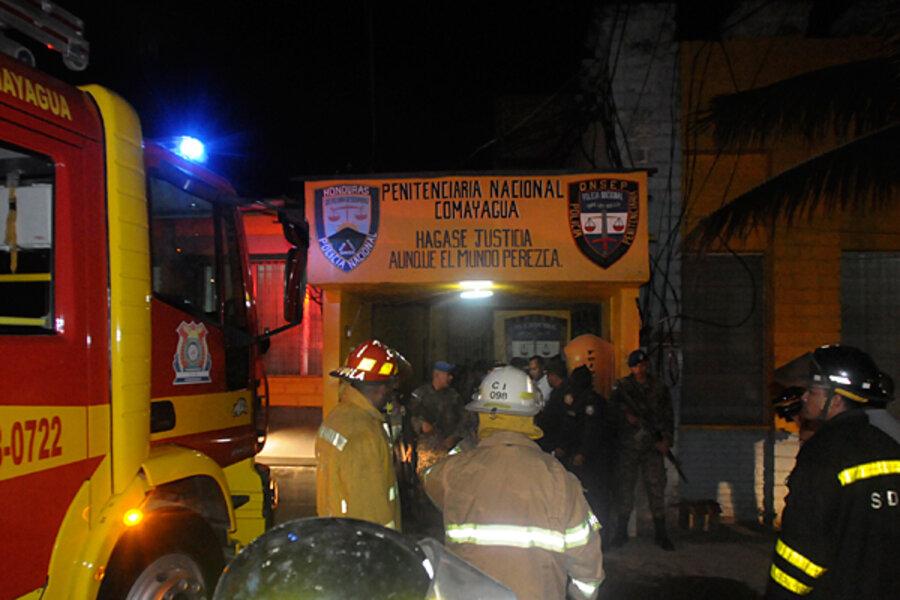Honduras prison fire kills more than 300, highlights regional problem
Loading...
A fire in a prison in Honduras killed at least 350 people late Tuesday night, authorities report.
It is still unclear how the fire, which broke out in the town of Comayagua, 90 miles north of the Honduran capital Tegucigalpa, started. Two theories posited so far include an intentional blaze set by inmates or an electrical short circuit.
The Associated Press reports that the prison held 800 prisoners, and well over a third were killed. A fire department spokesman told the wire service that at least 100 of the men died because they were unable to get out of their cells: the guard with the key could not be located.
Despite the uncertainty surrounding how the fire began, what is increasingly clear is that the region is regularly plagued by fatal fires that spread quickly, often due to building regulation violations, lax oversight, and poor contingency plans. While clear codes often exist, countries don't always have the capacity to enforce them and too often corrupt inspectors accept bribes instead of closing down illegal establishments.
[ Video is no longer available. ]
This is Honduras' third deadly prison fire since 2003, but fatal fires have claimed victims in various venues throughout the Americas in recent years, and often share characteristics such as overcrowding or lack of operational licenses.
Yesterday's fire follows a blaze in a rehabilitation center last month in Lima, Peru, where 27 people were killed after being trapped by flames. Authorities said the center, called “Christ is Love," was not licensed and was overcrowded.
Residents were kept inside the rehab center "like prisoners," Peru's health minister Alberto Tejada told the AP.
"You can supervise someone who has formally asked for permission to operate rehabilitation centers, but you're limited in how you can supervise someone who is hiding," Mr. Tejada said. CNN reports he promised to crackdown on centers operating "outside the law."
In Mexico, two tragedies have brought fire safety regulation to the fore. Last August, gunmen set a casino ablaze in the city of Monterrey. More than 50 died, many trapped behind blocked emergency doors, as reported in this guest blog by James Bosworth here. Mr. Bosworth writes:
Whether by arson, cigarettes, kitchen fire, or lightning strike, fires happen. There is no reason that a casino in a major metropolitan area like Monterrey should go up in flames so quickly while the majority of those inside cannot escape. What sort of materials were used in its construction? Where were the fire extinguishers and sprinkler systems? If this building wasn't up to code, then the question is why was it allowed to be open and who in the government failed in their duty to check on it? If it was up to code, then Monterrey and the federal government need to start revisiting those codes and updating them.
Why couldn't the fire department get to the building on time to rescue those inside? Did they lack equipment? Are they understaffed? Did someone fail in their duty? That investigation needs to happen.
Most importantly, why were the emergency exits blocked? It's not just Mexico. In too many cases around the region, emergency doors are locked or blocked by items that make them impassible. A few years ago, hundreds died in a market fire in Paraguay because emergency doors were locked and trapped people inside a burning death trap.
In June 2009, 49 victims were trapped inside another burning building in Mexico. This time the victims were children aged 3 or younger, attending daycare in the city of Hermosillo in northwest Mexico.
Safety and building code violations were documented as a major cause of the daycare tragedy in a new study led by David G. Greenhalgh, professor and chief of the burn division in the Department of Surgery at the University of California, Davis.
“We feel that all fire disasters need to be documented in some manner. If we do not dissect the causes of these tragedies then they are doomed to be repeated,” Mr. Greenhalgh said in a press release. “Many of the characteristics of this fire disaster have been observed previously. The main issue is that prevention efforts need to be followed.”
“Many of the fire laws that we have in the United States are the result of learning the specifics of previous tragedies. While the public may not understand why there are exit signs, multiple doors opening to the outside and other prevention efforts, laws and regular fire inspections have reduced the number of major burns and deaths tremendously,” Greenhalgh said. “Clearly, these same regulations exist in Mexico but they have not been regularly enforced. We do not wish to criticize the people or government of Mexico but instead, we published our paper to incite changes and prevent such a tragedy from happening again."







